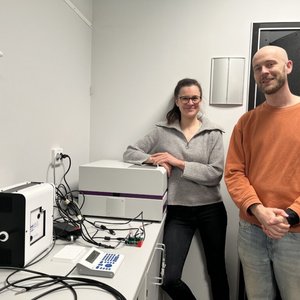The rapid progress in genetic technologies is set to have a profound impact on the future of animal breeding, particularly in aquaculture. At the North Atlantic Seafood Forum (NASF), experts from research institutions and aquaculture companies discussed the potential of gene editing technology in advancing fish health and promoting sustainable aquaculture. Among the experts, Ross Houston, director of Genetics & Innovation at Benchmark Genetics, discussed how these new technologies could be integrated into commercial aquaculture breeding programs.
“Gene editing and associated reproductive technologies would allow the industry to move faster and for a greater number of traits, via impact on several aspects of the breeders’ equation. These technologies are expected to be supplementary to selective breeding programs, not a replacement for them,” Houston said.
How can these technologies be integrated into commercial breeding programs?
Early work has been focused on routine heritable edits being introduced into the breeding nucleus animals to increase favorable QTL allele frequency but its application at a commercial scale offers some challenges, according to Houston. “The key difference between this theory and practice is that we don't know enough QTL causative variants that we would edit. Moreover, editing technology, at the moment, is not yet accurate and scalable enough to achieve this,” Houston said.
From a commercial breeding company's point of view, another issue is the varied regulatory landscape and the international aquaculture market which makes things a bit more complicated. “We want to have the option of gene-edited and non-gene-edited products to serve customer and regulatory requirements,” Houston said.
In terms of scalability, a lot of research has been done looking at ways to improve it. “For example, micro-injection of F0 embryos is very useful for research, but it has limited scalability and it's also challenging in some species, and can result in mosaic individuals,” Houston said.
“Benchmark is working on methods for mass-scale delivery, including via sperm and egg-mediated transfer for delivering molecules into fertilized eggs. This is a way to solve the scalability problem, but mosaicism is probably likely to remain an issue while this is still done in the F0 generation. Surrogate broodstock technology holds a lot of promise since it is a way that we can achieve both complete editing and scalability,” Ross said.
“For practical and technical reasons, gene editing is likely to be applied first into commercial lines rather than core breeding nucleus, via mass delivery or development of specialized edited lines, effectively giving us new genetic variation for target traits,” Houston said.
How can gene editing help ongoing breeding programs?
“It allows us to create new genetic variation and tackle traits with gene-editing technology rather than the existing genomic selection or family selection for those traits, for example, disease resistance or sterility. With such traits achieved via gene editing, it reduces the focus on these traits in the routine breeding program, meaning less need for disease challenge testing each year, and that we can put an increased selection pressure on the other traits,” Ross said. “We can go faster for other traits if we tackle one or more of our traits by gene editing.”
Focal traits for aquaculture breeding will primarily be disease resistance and sterility, giving concurrent benefits for animal welfare, production efficiency, and reduced environmental impact. Gene editing applications to resistance to sea lice was one of the projects discussed as an example of introgression by editing. The project targets the transfer of the trait of resistance to sea lice by identifying key genes and pathways in inter-species differential response, then using gene editing to introduce a coho-like response in Atlantic salmon.
Lessons learned from the livestock industry
Gene editing is still not applied commercially in Atlantic salmon breeding programs and remains at the R&D stage with Benchmark Genetics. However, it has been already commercially applied in the pig industry. This is the case of a disease called Porcine Reproductive and Respiratory Syndrome (PRRS) that has been challenging the global pig industry. Pigs infected with PRRS virus experience severe respiratory issues and breeding sows also suffer serious reproductive issues. It impacts multiple different stages of production, and no vaccine works.
Swine genetics company PIC partnered with university researchers to develop a solution using gene editing technology. PIC deleted a small portion of the pig’s DNA that encodes a protein the virus uses to attach, enter and infect the pigs’ cells. Without the ability to attach or bind, the PRRS virus is unable to enter the cell, replicate and infect the pig.
“As part of the FDA approval process in the United States, we had to demonstrate the efficacy of that. Utilizing type 1 and type 2, which are the North American and the European strains of the PERS virus, we saw these pigs are showing true resistance to the virus, a game changing,” said Craig Lewis, genetics service manager PIC, Genus.
The company has 43 patents issued in 37 countries as of Q4 2023 and entering the different markets is not an easy task. “In terms of regulation and dissemination, one of the things that we are learning is to make sure you understand your markets. We will not commercialize until we can make sure that the product can be accepted in the target markets,” said Lewis. This has direct applications in salmon production in Norway and the acceptance of these new technologies in the European market.
“Speaking to a farmer is a fundamentally different conversation than speaking to a consumer. Whereas a farmer might be interested in economics, the consumer wants to talk about animal welfare and antibiotic resistance. We need to understand different stakeholders, understand the disease that we are working with and how it impacts those stakeholders. Because, fundamentally, we've got to be very good as an animal protein sector when we talk about new technology integrating into a breeding program,” Lewis said.










